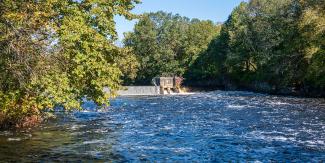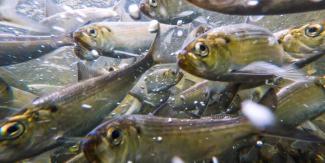Lower Blackstone River Fish Passage
River herring is the collective name for alewife (Alosa pseudoharengus) and blueback herring (Alosa aestivalis), which range from Florida to Canada and partake in what is considered one of the best-known fish migrations in New England. Alewife and blueback herring are known as anadromous fish, which are fish that migrate between freshwater and saltwater ecosystems but principally spawn in freshwater habitats. They are important to our ecosystem, as they are a critical part of the food chain for both saltwater and freshwater species, and they play an important role in keeping these systems stable. Migratory fish have been blocked from going up the Blackstone River since the 1700s.
Historically, these fish migrated to their spawning grounds in immeasurable numbers but have been on the decline for many years due to pollution, overfishing, and habitat loss. Additionally, the many colonial dams and mills built in Rhode Island have caused impassable barriers for fish trying to reach their spawning grounds. This has contributed greatly to the dramatic declines in their abundance as compared to historic levels.
The Lower Blackstone River Fish Passage Project seeks a path for achieving fish passage on the Blackstone River in Rhode Island to benefit the ecosystems, economies, and heritage of the river and the downstream Narragansett Bay and North Atlantic systems. Funding for this project is provided through DEM and the Narragansett Bay Estuary Program, with convening assistance from the Blackstone Watershed Collaborative, to enable The Nature Conservancy of Rhode Island to lead the development of a plan by 2024 for passing fish from Narragansett Bay to above the Valley Falls Dam on the Blackstone.
In 1997, the Corps of Engineers completed a Blackstone River Watershed Reconnaissance Investigation which identified opportunities for fish passage at four dams (Main Street, Slater Mill, Elizabeth Webbing, and Valley Falls Dams) between the Seekonk River and the Lonsdale area in Rhode Island. The U.S. Fish and Wildlife Service prepared conceptual plans for fish ladders at each of these dams.
In 2023, the Nature Conservancy was awarded a grant to hire Fuss & O’Neil to make a permit-ready 60% design for passage over the lower two dams. In 2024, they will move up river to explore what options are available for passage over the next two dams.
DEM, Narragansett Bay Estuary Program, The Nature Conservancy in Rhode Island, has moved forward with the design and construction of fish ladders at three of the dams (Main Street, Slater Mill and Valley Falls) with assistance from the Natural Resources Conservation Service (NRCS). The RIDEM purchased the Elizabeth Webbing dam and requested Corps assistance with a feasibility study to evaluate fish passage restoration alternatives in Central Falls. The Corps will evaluate an array of fish passage alternatives including dam removal, partial removal, nature-like passage and Denil ladder. Providing fish passage at these four dams would restore anadromous fish to the lower Blackstone River and would enhance the ecological value of the river for other aquatic species.


